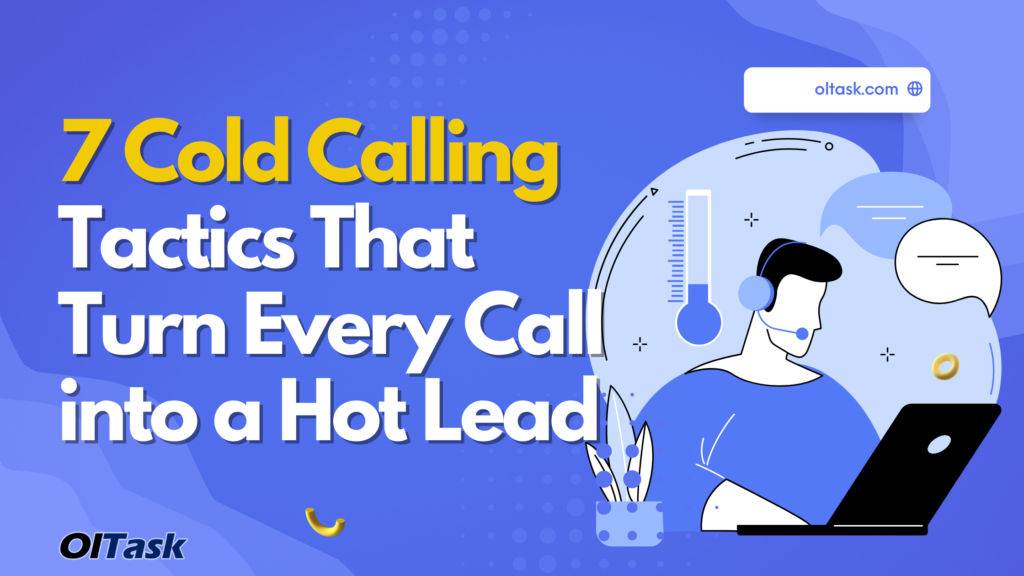Cold Calling Tips: Turn Every Call Into A Potential Sale

Cold calling serves as a pivotal method in sales outreach, although it isn’t without its hurdles. Yet, when wielded effectively, it holds the potential to yield substantial outcomes for your enterprise.
Throughout this piece, we will explore pragmatic approaches to heightening the efficacy of cold calling. Our aim is to equip you with tools that will transform each call into a potential sale, fostering growth for your business.
Understanding the Effectiveness of Cold Calling

Cold calling is more than just a sales technique; it’s a direct bridge between businesses and customers. In this section, we delve into the impact and intricacies of cold calling, exploring its role in building genuine connections and driving conversions.
Dissecting Cold Calling Success Rates
The numbers might surprise you – cold calling’s average success rate stands at about 2%. Sounds low, right? Yet, this seemingly small fraction can wield substantial influence over your business outcomes. How? Well, let’s break it down.
Suppose you make a hundred cold calls. From those, even a 2% conversion means two new potential leads. And from there, it’s a journey to transforming those leads into loyal customers. While 2% might seem unimpressive, it’s a seed that can grow into something substantial.
Why Cold Calling Still Matters
In a world dominated by emails, chats, and automated messages, a personal voice on the other end of the line stands out. People still appreciate talking to another person, having a dialogue, and receiving immediate responses.
That’s where cold calling gains an edge. It’s like having a face-to-face conversation in the digital realm, allowing you to convey sincerity and build trust. In a world where digital interactions can feel impersonal, your voice can resonate and establish a real connection.
Crafting Your Call List Strategically

When it comes to cold calling, a well-thought-out strategy can make all the difference. Random dialing won’t yield the best results. By strategically segmenting your call list and personalizing your approach, you can ensure that every call counts.
Segmentation for Success
- Break down your call list into segments based on similar characteristics.
- Each segment represents a specific target persona with distinct needs.
- Tailor your approach to each segment, addressing pain points and goals.
Segmentation Example: If you’re calling both e-commerce entrepreneurs and B2B companies, your script and approach will differ. E-commerce owners might be more interested in abandoned cart recovery, while B2B firms may seek outbound sales support.
Research and Personalization
- Research each prospect’s company, industry, and recent developments.
- Find common ground to spark meaningful conversations.
- Personalize your opening statement with relevant information.
Personalization Example: “Hi [Prospect’s Name], I noticed your company recently expanded into [new market]. How’s that journey been for you? We’ve helped similar businesses navigate new territories.”.
Mastering the Initial Moments

The beginning of a cold call holds immense potential. Those first few seconds can determine the direction of the conversation. Crafting a strong introduction is your chance to grab attention and set the stage for a meaningful exchange.
The Power of a Strong Introduction
- Open with a brief, impactful statement that piques interest.
- Highlight a specific benefit your solution offers.
- Tailor your statement to resonate with the prospect’s pain points.
Introduction Example: Imagine saying, “Hello [Prospect’s Name], I’ve assisted businesses similar to yours in boosting revenue by 30% using strategic sales tactics. Let’s discuss how we can achieve similar results for you.”
Elevator Pitch Perfection
- Summarize your value proposition in 15 seconds.
- Emphasize the concrete benefits you bring.
- Convey how your solutions solve the prospect’s challenges.
Elevator Pitch Example: When asked what you do, respond with, “We specialize in outbound sales solutions that drive real ROI. Would you like to hear how we’ve helped clients achieve a 40% increase in their conversion rates?”
These initial moments set the tone for the conversation and establish the value you can provide. By focusing on benefits and relevance, you capture the prospect’s attention and lay the foundation for a meaningful dialogue.
Building Rapport and Addressing Pain Points

Building rapport swiftly and addressing pain points effectively can be the difference between a productive conversation and a lost opportunity. This section delves into techniques that help you connect with prospects on a personal level and offer solutions tailored to their specific challenges.
Listening as a Strategy
- Pay close attention to what prospects say during the call.
- Use their words to empathize and offer tailored solutions.
- Show that you’re focused on helping them overcome challenges.
Listening Example: If a prospect mentions struggling with lead generation, respond with, “I understand that lead generation can be tough. We’ve successfully boosted leads by 40% for clients in your industry.”
Solving Pain Points in Real Time
- When a pain point arises, address it immediately.
- Offer a brief solution or insight that aligns with their needs.
- This demonstrates your expertise and problem-solving approach.
Solving Example: If a prospect expresses concerns about managing inbound calls, respond with, “Handling inbound calls efficiently is crucial. Our call center services can provide the right support and ensure no call goes unanswered.”
Effective Communication Techniques

In the realm of cold calling, effective communication is paramount. This section delves into strategies that engage prospects and foster meaningful dialogue for successful outcomes.
Storytelling for Engagement
- Share real examples of how your solutions have benefited others.
- Use relatable narratives to captivate prospects’ attention.
- Stories make your services more tangible and relatable.
Storytelling Example: “We recently worked with a startup like yours. They went from struggling with lead conversions to achieving a 25% increase in just three months.”
Asking Open-Ended Questions
- Use questions that can’t be answered with a simple “yes” or “no.”
- Encourage prospects to share more about their challenges.
- This fosters dialogue and helps you understand their needs better.
Question Example: “Can you tell me more about your current outbound sales process? Are there any pain points you’ve identified?”
Overcoming Objections Gracefully

Navigating objections is a fundamental skill in successful cold calling. In this section, we’ll explore how to handle objections with finesse and transform them into opportunities for meaningful conversations.
Anticipating Common Objections
- Expect objections like “I’m not interested” or “It’s not in our budget.”
- Prepare concise responses that acknowledge the objection.
- Maintain empathy and keep the conversation flowing smoothly.
Objection Response Example: When met with “I’m not interested,” reply with, “I understand. May I quickly share a success story about a client who felt the same way initially?”
Turning Objections into Opportunities
- Use objections as chances to offer value.
- Address the objection and pivot to a benefit.
- Link the objection to a positive outcome they might achieve.
Objection Conversion Example: If the objection is about budget, say, “Budget is a concern for many. Let’s explore how our services often lead to a swift ROI. Does that sound appealing to you?”
Closing the Call with Purpose

As a cold call nears its end, your approach matters. Discover the art of the soft close and learn to smoothly transition to the next steps for a fruitful conversation.
The Art of the Soft Close
- Avoid a hard sell; close with a gentle question.
- Use language that encourages further discussion.
- Invite prospects to continue the conversation naturally.
Soft Close Example: Instead of pushing, say, “Based on what we’ve discussed, does it make sense to continue this discussion?”
Scheduling Next Steps
- Transition from the main call to a follow-up smoothly.
- Suggest a specific action for the next interaction.
- Offer a clear timeframe for the follow-up.
Scheduling Example: “I appreciate our conversation. Would you be open to a deeper dive in a 15-minute call next week? It’ll help us explore your needs further.”
Following Up for Continued Engagement

A consistent follow-up plan ensures you stay on the prospect’s radar and build a foundation for a deeper business relationship. It demonstrates your dedication and willingness to support their needs.
The Importance of Follow-Up
- After the initial call, follow-up is crucial for nurturing leads.
- It reinforces your value proposition and keeps your business top of mind.
- Send a concise email summarizing the conversation and the benefits you discussed.
Follow-Up Email Example: Thank you for our call, [Prospect’s Name]. Just to recap, we discussed how our outbound sales strategies have boosted conversion rates by 40% for similar businesses. Let’s explore how this could work for you.
Creating a Follow-Up Plan
- A well-structured follow-up plan maintains engagement.
- Plan multiple touchpoints, including emails and follow-up calls.
- Each touchpoint adds value, answers questions, and keeps the conversation flowing.
Follow-Up Plan Example:
- Day 2: Send an email with additional success stories.
- Day 5: Call to address any questions or concerns.
- Day 10: Share a relevant industry article via email.
Measuring and Iterating for Success

Success in cold calling isn’t just about making calls; it’s about measuring what works and adapting for better outcomes. This section delves into the metrics and strategies that pave the way for continuous improvement.
Metrics that Matter
- Gauge cold calling effectiveness with key metrics.
- Monitor call-to-conversion rate – the ratio of successful calls to conversions.
- Track average call duration to assess engagement levels.
OlTask’s role comes into play here. Our efficient call center services not only manage calls but also measure these vital metrics to ensure your cold calling efforts are yielding valuable results.
Continuous Improvement
- Leverage metrics to refine your cold calling approach.
- Analyze data to identify patterns and opportunities for enhancement.
- Experiment with various scripts, opening lines, and communication techniques.
With OlTask’s expertise, you can analyze data collaboratively and tailor your strategies based on real insights, consistently enhancing your cold calling outcomes.
Next Steps for Cold Calling Excellence

Mastering cold calling is an investment with tangible rewards. Here’s how to keep the momentum.
- Invest in training: Equip your team with the latest techniques and insights to optimize their cold calling skills.
- Embrace technology: Leverage OlTask’s Customer Relationship Management (CRM) tools to enhance personalization and communication efficiency.
- Measure and adapt: Continuously evaluate metrics and adapt your approach based on real-time feedback.
Ready to enhance your revenue through efficient sales strategies? OlTask’s experts are dedicated to helping you elevate your cold calling game and drive remarkable conversions. Contact us today to embark on this journey to success.